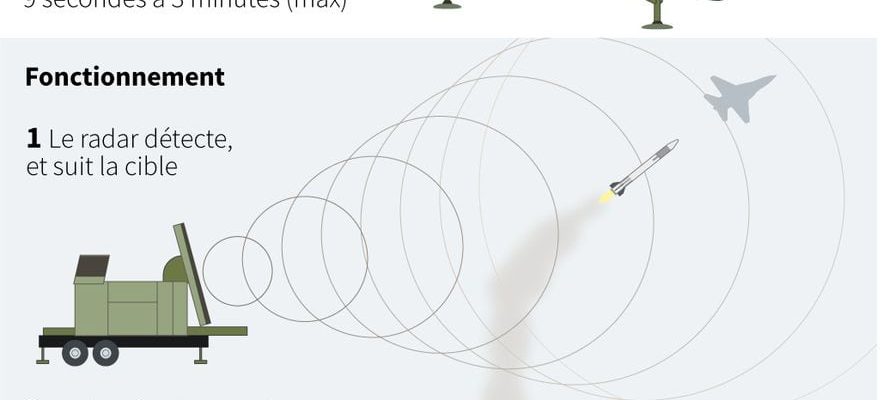This is a new turning point taken by the war in Ukraine. Since its devastating air offensive on December 29 on several major Ukrainian cities including kyiv and Kharviv, which caused more than 50 deaths and hundreds of injuries, Russia has been attacking Ukraine with particularly violent air operations.
According to President Volodymyr Zelensky, Russia has sent nearly 300 missiles and more than 200 Shahed explosive drones against Ukraine since December 29 alone. This new intensification of the conflict has directly put the question of Ukrainian armament against the Russian invader at the center of the debate. And more in particular, its anti-aircraft defense capabilities, vital to protect its territory and its population.
The essential Patriot systems
At the spearhead of Ukrainian anti-aircraft defense are the essential American Patriot systems, built by the defense giant Raytheon. Recognized for their almost unparalleled efficiency, capable of detecting planes or missiles at more than 100 kilometers, Patriot batteries had already proven their effectiveness to the whole world during the Gulf War in the 1990s. Since then, they have remained among the the most sophisticated air defense systems in the world.
Promised in December 2022 and January 2023 by the United States, Germany and the Netherlands, the first Patriot batteries were delivered to Ukraine in April 2023, marking a major turning point in the balance of forces between kyiv and Moscow. An armament which has since continued to increase, particularly with the approach of this winter when Russian attacks were expected to be much more intense, and rightly so. Last December, Ukraine announced that it had received a second Patriot defense system from Germany, before on December 19, kyiv again assured that it would receive “several” new Patriot systems, without specifying the exact number.
Proof of the formidable effectiveness of Patriot batteries: on January 2, kyiv announced that it had shot down 10 Russian Kinjal missiles using the American system, “a record” according to the army. These hypersonic projectiles, presented as “invincible” and infallible by Putin, fly at more than five times the speed of sound, or above 6,000 km/hour. Killing 10 in the same day marks the certain rise in power of the Ukrainian defenses.
Explanatory sheet on the Patriot surface-to-air missile system
© / AFP
Franco-Italian equipment
France, for its part, is also involved in anti-aircraft defense assistance, through another system equivalent to the Patriot, called SAMP/T MAMBA. Of Franco-Italian design, equipped with a very sophisticated radar and launchers armed with eight Aster missiles with a range of approximately 100 kilometers, it makes it possible to “counter a wide range of aerial threats: short-range ballistic missiles, fighter planes, helicopters, drones and even salvos of cruise missiles with multiple shots,” a French soldier told AFP in December 2022.
To ensure the defense of its air, Ukraine can count on less sophisticated but also particularly useful mobile equipment, whether portable Stinger surface-to-air missiles or shorter-range German Iris-T SLM missile launcher systems. or even Gepard anti-aircraft armored vehicles, nicknamed “drone killers”.
Finally, one last asset is particularly awaited by Ukraine in order to be able to defend its air: the famous F-16, these American fighter planes. At the end of December, the Netherlands announced that they would deliver their “first” 18 F-16 planes to kyiv, while more than 60 of these planes were promised in total by the West to kyiv. With one problem, about to be resolved: the training of Ukrainian pilots to operate these very modern machines.
The ammunition problem
Having the systems in place is one thing; having sufficient ammunition to be able to respond day after day to the incessant Russian attacks is another. It is precisely this point that worries kyiv, in the midst of doubt about the sustainability of Western support. Because the Patriot system has a significant price. According to Center for Strategic and International Studies (CSIS), the cost of a complete Patriot battery is estimated at nearly $1.1 billion: $400 million for the system, $690 million for the missiles. Individually, a Patriot missile alone would cost nearly $4.1 million.
“In the current situation, with regard to mobile air defense systems, ammunition […] are sufficient to resist the next powerful attacks”, wanted to reassure General Serguiï Naïev, commander of the Ukrainian joint forces, interviewed Wednesday by AFP during a meeting with other soldiers near Kiev. “But in medium and In the long term, we of course need the help of Western countries to replenish the stock of missiles”, adds the man who is in charge of these units responsible in particular for defending the skies of the capital.
Faced with this intensification of Russian attacks, the head of Ukrainian diplomacy, Dmytro Kouleba, also requested the acceleration of Western deliveries of “additional anti-aircraft defense systems, combat drones” and “missiles with a longer range 300 kilometers.
A race against time
Moscow understands this very well, and thus seems to be entering a new phase of attrition, in order to test and exhaust Ukrainian anti-aircraft defenses. According to Mick Ryan, a CSIS associate researcher and now retired Australian general, Russia is in a race against time, hoping that “Ukraine will run out of interceptors before Russia runs out of missiles.” and drones”, he noted on X (formerly Twitter).
This is the whole objective of a meeting which will take place next week in Brussels between NATO and Ukrainian officials, where kyiv will once again demand more military equipment. With a question, which has constantly come up for almost two years now: will Ukraine hold on?
